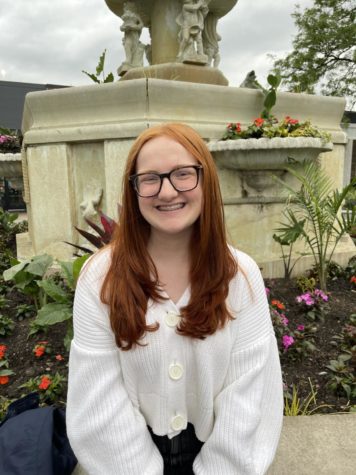Opinion | Transparent policing provides first step towards equity
November 16, 2020
“There is a misunderstanding between society and the criminal justice system in America. I feel that there have been some steps in the right directions, particularly in certain communities, to create a more equitable criminal justice system. However, there is still much more to change,” says humanities history and civics teacher Timothy Foecking. “Today, our criminal justice system cares more about you if you are rich and white than if you are poor and Black. The data shows this with the large discrepancy based on race and wealth in our current prison system. In order to change this, our criminal justice system needs to create more equitable practices that values justice for all and allows the same access to justice for everyone despite your race or socioeconomic status. However, this is much easier said than done. The criminal justice system is large and complex, so changing its practices will be difficult and tedious. It all starts with a mind shift and eliminating systemic racism from the criminal justice system’s practices and valuing Black lives in the justice system.”
The current state of our criminal justice system needs significant reform. The actions it has taken against communities of color are unacceptable. While changes are trying to be made, steps to a more equitable system must be prioritized and accomplished. The most important step in that process to equity is greater transparency. By offering communities, especially communities of color, greater transparency between them and the officials meant to serve them, our country can achieve the equitable criminal justice system it desperately needs.
“The criminal justice system is broken and that leads to discrimination against the Black/brown community, which is mostly who are in the system looking for help. That help doesn’t come most of the time. It needs to be fixed, because people have no trust in the system. Nobody should be afraid of it, and some people are. We need to rebuild the system [based] on honesty and justice for everyone, so they feel safe again trying to get help,” says junior Shania Wright.
Transparency in our criminal justice system can be seen in a variety of ways. One of the more common ways transparency is being implemented in our criminal justice system is through body cameras. This allows for video proof of the events that occurred and can verify eyewitness testimonies. These videos cannot be contorted or changed like police testimonies. It provides physical proof of what actually occurred.
While officers still could turn their cameras off too late to capture the events, these cameras are still useful tools. They show people what actually happened without any severe refutation that it could be fake. The current state of mistrust among communities and police can be shifted by body camera videos that show the reality of the interactions. Body cameras in current use have shown their necessity, especially when it comes to the courtrooms.
“For 100 years, courts have faced a ‘he said, she said’ dilemma, as police officers describe one set of events, and defendants another. Now we have a more neutral witness,” said Kade Crawford, director of the ACLU’s Technology for Liberty Program in an interview with The Boston Globe. “These videos and court orders show us body cameras can play a critical role in criminal cases, to help judges determine what really happened.”
The increased transparency within body cameras are a start to greater equity. They can be used as a deterrent measure to make sure harmful actions are not taken against people. They also make sure there is not faulty witness testimony and work to make the criminal justice system slightly more equitable and credible. This greater transparency is especially seen when these videos are released to the general public, showing communities that they have nothing to fear and, if they do make mistakes, are willing to accept the consequences of their actions. The transparency given by body cameras starts the criminal justice system on the path to equity, along with the other methods that police departments have been using.
“Transparency between the police and community is very important. It is the best way to maintain public trust, especially considering all the scrutiny law enforcement is under from a national perspective. When major incidents occur in Evanston, we complete press releases to the local and regional media, sharing as many facts about the incident as we can. We also have an up-to-date dashboard on the police page of the city webpage. The dashboard contains information regarding crimes in Evanston, traffic stop demographics, citations issued and the racial makeup of those receiving citations, traffic crash data, weapon recovery information, previous years police complaint information,” says Evanston Police Department Commander Brian Henry. “The Evanston Police department also releases a crime bulletin three times a week, which includes crime info and arrest info from the previous day or couple days. We also constantly update our Facebook page and Twitter account. The more the public knows what, why and how we do what we do, can take much of the guessing out of the equation. I think having community meetings and discussing concerns or answering questions is also very important, which EPD has historically done through our Problem Solving Team. Unfortunately, community meetings have been greatly affected by [COVID-19]. ”
Another way greater transparency is being recognized in the criminal justice system is through court notes and files being released. By releasing all court records to the public, the court system is offering greater transparency. People can take notice of all the events that take place and people that make up the courtroom. They can see if there is a biased judge or an incompetent lawyer. All of the discrepancies in court that are not recognized due to their limited access can be recognized by releasing court information. This results in a benefit to both the people and those in court. The people get to know what is going on in their community and learn about some of what occurs in the courtroom, both good and bad. The people in the courtroom have another group of people checking their actions. In some cases, this can result in information that leads to a more fair trial in the future. The Illinois State’s Attorney’s Office is currently doing this, and it has been beneficial to them in their efforts for creating a better prosecutorial system.
“The efforts made by the Cook County State’s Attorney’s Office (CCSAO) over the past three and a half years show a great roadmap for progressive changes in prosecutor’s offices. You can see these efforts in the unprecedented levels of transparency through our open data portal which allows anyone to look through thousands of cases that our office handles every year,” says Deputy Chief of Staff with the CCSAO Alyson Miller. “We have worked to restore faith in the justice system through our Conviction Integrity Unit, which has vacated 100 cases for 83 people under the Kim Foxx administration [Cook County State Attorney]. Additionally, we have taken responsibility for the role prosecutors played in the failed war on drugs and own the harm that was caused, especially for communities of color.”
Both body cameras and releasing court records are key when trying to achieve equity in the criminal justice system. They open both the police and courtrooms to greater criticisms from the community by offering them with all the information, rather than just a select percentage of the facts. By doing this, equity can be achieved through the insight of an entire community, rather than a small group of people. By bringing more people into the conversations and interactions of our criminal justice system, transparency that can lead to equity is seen. While transparency does not solve all the issues with our criminal justice system, it is a key step in the process. Greater transparency works to benefit everyone and by calling on communities to push for greater transparency, equity will ensure.











